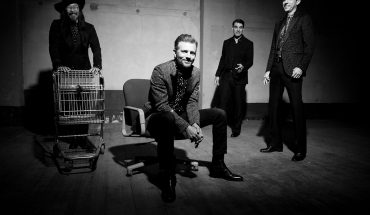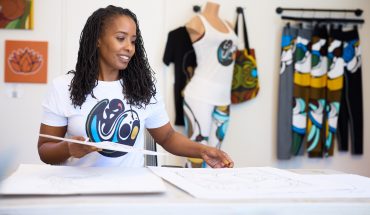by Sarah Schroth
Mary D.B.T. and James H. Semans Director
Nasher Museum of Art at Duke University
Art museums are, for me, almost sacred spaces of contemplation.
If I slow down and take enough time to look at a work of art, look really hard, it can move me to tears, make me laugh, perplex me, cause me to stand in awe as witness to the mind and hand of someone who can create beauty and meaning in an image. This rarely takes place in a matter of seconds, and is difficult to do in our time-demanding, hurry-up world. But from long experience, I know that the longer I look, the more I will see, the more I will feel, the more I will understand, the more I will get out of the experience.
I grew up in a small town in Virginia, hours from any museum. My parents were not museum-goers, but my Irish Catholic mother well understood the power of images and my father knew the importance and joy of close observation, which he passed on to his six children. My first real museum experience was as a college sophomore. An assignment for an art history class required that we write a paper on a single work of art hanging in a nearby museum.
I don’t remember how I came to choose J.M.W. Turner’s 1807 seascape, The Junction of the Thames and the Medway at the National Gallery of Art in Washington, D.C. I do vividly remember sitting on the floor in front of the large painting of swirling colors for what seemed to me a long time, not feeling anything, not knowing what to write about, a complete novice. On the second visit, I forced myself to stay put, to keep looking until I could be inspired to write something. I noted the dark cloud formations above a rough body of water populated with boats being tossed about. By the third visit, the friendly guard recognized me, we shared a few observations. I was comfortable, felt at home. The museum had become my own, by now the painting was a familiar presence. Each visit, I saw new things in the picture.
On the third visit the magic happened. I suddenly felt the fear that the seamen were experiencing in the stormy sea Turner depicted. I empathized with their plight. I realized J.M.W. Turner had been able to capture an abstract emotion with abstract means, pigment and oil.
A whole new world opened up.
That assignment was so much fun that I changed my major from speech pathology to art history, and went on to devote my life to looking at and studying art, eventually earning a Ph.D. I longed to help others discover the joys of seeing, to feel the excitement of a good museum experience.
Fast forward to the present. After more than 20 years as a curator, I am now a museum director. You might be surprised by how often I am reminded of that first experience.
Recently I heard a lecture about new research tracking changes in the brain’s activity due to multitasking, which has become ubiquitous in today’s world of smart phones, multi-screened TVs with thousands of channels, instant messaging, etc. The speaker explained that while certain areas of the brain are being developed in response to this aspect of our contemporary world, the quick decisions necessary for multitasking are actually disrupting the neurons in the region of the brain responsible for making us feel empathy, the right supramarginal gyrus.
I thought of the children who have grown up with remotes in their hands, using their thumbs faster than humans have ever done, while talking on the phone and watching TV, skillfully handling and processing so much information at once from so many sources. I thought of the lack of actual, one-on-one, nonviral contact that our electronic existence has created. And I began to worry about lack of empathy, especially in our youth.
To be empathetic is get outside of yourself in order to care about others, be sensitive to their feelings, their background, their culture, to have the capacity for participating in another’s feelings or ideas. As a museum professional, I immediately begin thinking of the museum experience as a way to combat the potential lack of empathy, or as a tool to develop empathy.
A few months ago, I had a particularly strong empathic response triggered by a new work of art. I was at the granddaddy of all art fairs, Art Basel in Basel, Switzerland. Outside the main fair, in the Unlimited section, I discovered Guido van der Werve’s 2012 film, Nummer veertien, home. It is a complicated, beautiful, professionally flawless 54-minute film divided into three movements and 12 acts, with three different narratives intertwined – the death of Chopin, the story of Alexander the Great, and the artist’s own journey.
The film opens with text telling us that although Chopin was buried in Paris, his dying request was to bury his heart in his native Poland, a wish his sister carried out. Next we hear the sound of a single piano playing a slow, melancholic melody while the camera pans the white marble tomb holding Chopin’s heart in an ornate church in Warsaw.
The camera pulls back to reveal the pianist playing this requiem, incongruously dressed in a black wet suit, a hint at van der Werve’s signature deadpan, surrealistic style. This is the beginning of the actor retracing the path taken by Chopin’s sister in reverse – starting from the church, he swims, bikes, and runs more than 1,000 miles from Poland to Paris.
This trip is interspersed with the story of the artist’s own journey and Alexander the Great’s – both leaving home and unable to return. All the while, this beautiful requiem for voices and strings plays on. There is no dialogue.
It is only in the credits that we learn that the artist himself composed and played the requiem and endured the extremely physical 1,000-mile journey in less than three weeks. It was so heartbreaking and powerful that I could not move; I stayed for the full length of the film. By its end I was awestruck at the Dutch artist’s sheer effort and talent. But even more importantly, this film enabled me to participate in the universal emotion of longing for home felt by Chopin, Alexander the Great, the artist. I was in their shoes, outside myself, transported. I experienced empathy.




